Bacteria
were firmly rejected as a cause of cancer by medical science a
hundred years ago. So why would any researcher claim that “cancer
germs” cause breast cancer? It’s because pleomorphic bacteria can
actually be seen in cancerous tissue; and a few physicians have
been describing these unusual (and extremely controversial) bacteria
since the late 19th
century. Pleomorphic bacteria associated with cancer have more than
one morphological form or appearance. When grown in lab culture and
injected into mice they have been reported to increase the animals’
incidence of cancer. The microbe has been re-cultured from the animal
cancer, this fulfilling “Koch’s postulates” — the proof
required to establish a causative connection. For more details on
pleomorphism in bacteria, consult the Wikipedia.
Since
the “War on Cancer” in the 1960s, billions of dollars have been
spent trying to find a viral (but not bacterial) cause of breast
cancer. However, as of 2013 it now appears that viruses have finally
been eliminated as a cause. Ka-Wei Tang, MD, one of the authors of a
genetic analysis study of 4000 tumors, states: “In
cancer research and treatment, there has been a lot of focus on
associations that have not been proven, some of which have actually
have been shown to be wrong. Researchers are starting to realize that
we need truly unbiased methods to uncover meaningful associations.”
Unlike bacteria, viruses
are too small to be viewed with the ordinary light microscope. But bacteria
are large enough to be seen at the highest magnification (usually 1000
times, with an oiled lens) of the microscope.
William
Russell (1852-1940) and "the parasite of cancer"
Near the close
of the nineteenth century when major diseases like tuberculosis, leprosy,
and syphilis were finally being widely accepted as bacterial infections,
it was also thought that bacteria might also be implicated in cancer.
On December 3, 1890, William Russell, a pathologist at the School of Medicine
in Edinburgh, gave an address to the Pathological Society of London in
which he outlined his microscopic findings of "a characteristic organism
of cancer" that he observed in fuchsine-stained tissue sections from
all forms of cancer he examined. He also noticed them in certain cases
of tuberculosis, syphilis and skin infection.
The parasite
was seen within the tissue cells and outside the cells (intracellular
and extracellular). Their granular and round coccoid-shaped forms ranged
in size from barely visible, up to "half again as large as a red
blood corpuscle." The largest round forms suggested a fungal-like
or yeast-like parasite. Russell provisionally classified the parasite
as a possible "blastomycete" (a type of fungus); and called
the tissue forms "fuchsine bodies" because of their bluish-red
staining qualities.
At
the time, it was thought that each species of microbe could only give
rise to a single disease. In 1899, in yet another report on "The
parasite of cancer" (The
Lancet,
April 29), Russell admitted he could sometimes detect cancer parasites
in diseases other than cancer, and that this was indeed a "stumbling
block." At this point a considerable number of scientists concluded
that Russell bodies were merely the result of cellular degeneration of
one kind or another. Furthermore, no consistent microbe was cultured from
tumors; and attempts to induce cancer tumors in animals gave conflicting
and often negative results. Russell was a pathologist,
not a microbiologist, and he avoided controversies surrounding the cancer
microbe theory. He simply concluded, "It seems almost needless to
add that there remains abundant work to be done in this important and
attractive field."
After
three years' work at the New York State Pathological Laboratory of the
University of Buffalo, Harvey Gaylord confirmed Russell's research in
a 36-page report titled "The protozoon of cancer", published
in May, 1901, in The
American Journal of the Medical Sciences.
Gaylord found Russell’s bodies in every cancer he examined, as well as
large spherical bodies 2 to 3 times larger than red blood cells. But the
most frequently seen round forms were the size of ordinary staphylococci.
Russell's “parasites”
became widely known to pathologists as Russell bodies. They are currently
considered to be “immunoglobulins” and non-microbial in origin. This report
will suggest that pleomorphic Russell bodies actually represent extreme
bacterial pleomorphism, a feature of so-called call wall-deficient bacteria
described in recent decades. (For more on this, view ‘The Russell body:
The forgotten clue to the bacterial cause of cancer’ (2003) and ‘The return
of the cancer parasite’ (2011) online.
The heresy of the cancer microbe
The death kneel for
a cancer germ resulted when famous pathologist James Ewing declared in
1919 that "Few competent observers consider it (the parasitic theory)
as a possible explanation in cancer." Doctors eventually assessed
cancer bacteria as laboratory contaminants or as secondary invader microbes
that infect tissue after cancer has formed. Subsequently, few researchers
dared to contradict Ewing by investigating bacteria in cancer.
Nevertheless,
during the 1920s a few persistent physicians, such as pathologist
John Nuzum of the University of Illinois College of Medicine; surgeon
Michael Scott from Butte, Montana; and obstetrician James Young of
Edinburgh, Scotland, published research showing that a particular
type of bacteria was consistently observed and cultured in breast
cancer. The pleomorphic germ defied the established laws of
microbiology by its ability to change shape and form, depending on
how it was cultured in the laboratory, the age of the culture, and
the amount of oxygen supplied for growth.
At
first, the germ in culture was barely visible as tiny round coccal
forms. Later, these cocci might morph into rod-shaped bacteria, which
could connect together to form filamentous chains resembling a
fungus. Small cocci could also enlarge into yeast-like and
fungal-like spore forms.
Nuzum
grew his "micrococcus" from 38 of 41 early breast cancers,
and from cancerous lymph nodes and metastatic tumors resulting from
spread of the cancer to other parts of the body. With special stains
he detected these small round coccoid forms within the breast cancer
tumor cells. During his 6 years of intensive bacteriological study,
he learned the microbe could pass through a filter designed to hold
back bacteria, indicating that some forms of the microbe were as
small as some viruses. Although Nuzum couldn't produce cancer tumors
in mice, he was able to induce breast cancer tumors in 2 of 5 dogs
injected with the microbe.
Young
found his microbe in 16 cases of breast cancer, and in two mice with
breast cancer. He identified "spore forms" and clumped
"spore balls" in microscopic sections prepared from the
mouse tumors. Scott described three stages in the life cycle of his
pleomorphic bacteria —the rod forms, the spore or coccus-like
forms, and larger spore-sacs resembling a fungus. He claimed to
treat cancer patients with an effective antiserum against these
microbes, and spent the rest of his life trying to alert colleagues
to the infectious cause of cancer. But the antagonism to Scott's
parasites and his antiserum was overwhelming, and he died a broken
man. His sad story is told in The
Cancer Conspiracy
[1981] by Robert Netterberg and Robert Taylor.
The full papers of
these men are seminal and valuable reading for anyone interested in
the microbiology of breast cancer. They were retrieved for me by
dedicated medical librarians who resurrected these totally forgotten
scientific reports “long buried in the medical literature,” as my
old dermatology profession used to say. It is unfortunate that they
are not posted on the Internet by some well-funded breast cancer
foundation seeking a cause and a cure.
Four women and their cancer bacteria discoveries
During
the last half of the 20th
century cancer microbe research was barely kept alive by a quartet of
women, who were my friends but now have all passed away. The combined
published research of Virginia Wuerthele-Caspe Livingston-Wheeler (a physician),
Eleanor Alexander-Jackson (a microbiologist), Irene Diller (a cellular
biologist) and Florence Seibert (a biochemist) provides indisputable evidence
that bacteria are implicated in cancer.
Livingston
independently discovered the cancer microbe in the late 1940s and
never stopped promoting it until her death in 1990, at the age of
84. She stressed the pleomorphic microbe could be identified in
tissue and in culture by use of the “acid-fast stain,” a
traditional stain used to identify the rod forms of the tubercle
bacillus and stains them a red color. She was greatly aided by TB
microbe expert Alexander-Jackson, who supplied the bacteriologic
expertise. Like previous researchers they confirmed the microbe was
filterable and virus-like in some stages.
In
1965, they wrote: “This organism is a great simulator, whose
various forms may resemble micrococci, diphtheroids, bacilli, fungi,
viruses and host-cell inclusions. Yet if the developmental cycle of
the organism is studied by following it through all its transitional
stages, it can be identified as a single agent.” In 1974, the two
women named their microbe "Progenitor cryptocides" (Greek
for “hidden-killer”), causing an uproar among cancer experts,
microbiologists, and the American Cancer Society, all of whom
insisted such a perverse microbe did not exist!
In
the 1950s Irene Diller of the Institute for Cancer Research at Fox
Chase, Philadelphia, discovered fungus-like spicules emanating from
cancer cells. Joining forces with the Livingston team, Diller worked
with specially bred mice with a proven cancer incidence. By injecting
them with bacteria cultured from breast cancer and other tumors, she
was able to more than double the cancer incidence of the mice. When
cancer tumors developed she successfully cultured the microbe from
them — fulfilling Koch’s postulates. Diller also grew the microbe
from the blood of cancer patients.
In
the early 1960s Florence Seibert, noted biochemist and tuberculosis
icon became so impressed with the three women’s research that she
came out of retirement to help prove that bacteria caused cancer.
Back in the 1920s Seibert devised a method to make intravenous
transfusions safe by eliminating contaminating ubiquitous bacteria.
Later, she perfected the skin test for tuberculosis that has been
used worldwide ever since. In 1938, she was awarded the famed Trudeau
Medal, the highest prize given to tuberculosis research.
Experiments conducted by Seibert and her team
showed these TB-like cancer microbes were not laboratory contaminants
because they were able to isolate bacteria from every tumor (and every
leukemic blood) they studied. And when “immediate imprints” of fresh cancerous
breast tissue were smeared onto a slide and stained, the coccus forms
of the bacteria were easily identified. (See Figure 6A in her 1972 paper
‘Bacteria in Tumors’, written with Irene Diller and colleagues.)
In
her autobiography, Pebbles
on the Hill of a Scientist,
published privately in 1968, she wrote: "One of the most
interesting properties of these bacteria is their great pleomorphism.
For example, they readily change their shape from round cocci, to
elongated rods, and even to thread-like filaments depending upon what
medium they grow on and how long they grow. This may be one of the
reasons why they have been overlooked or considered to be
heterogenous contaminants... And even more interesting than this is
the fact that these bacteria have a filterable form in their life
cycle; that is, that they can become so small that they pass through
bacterial filters which hold back bacteria. This is what viruses do,
and is one of the main criteria of a virus, separating them from
bacteria. But the viruses also will not live on artificial media like
these bacteria do. They need body tissue to grow on. Our filterable
form, however, can be recovered again on ordinary artificial
bacterial media and will grow on these. This should interest the
virus workers very much and should cause them to ask themselves how
many of the viruses may not be filterable forms of our bacteria."
Seibert's
provocative papers, some published by the prestigious Annals
of the New York Academy of Sciences,
should have caused a stir. But with the quartet slowly closing in on
the bacterial cause of cancer, funds from previous supporters (like
the American Cancer Society) suddenly dried up. All cancer microbe
researchers eventually discovered that studying cancer bacteria was
the kiss of death as far as funding was concerned. And without
adequate funding, cancer microbe research was made more difficult, if
not impossible.
But
coming from thirty years of TB research, Seibert knew that the
discovery of a pleomorphic and intermittently acid-fast microbe in
cancer was tremendously important. She fervently believed that
knowledge of this microbe would be instrumental in developing a
possible vaccine and more effective antibiotic therapy against
cancer. In Pebbles
she confided: "It is very difficult to understand the lack of
interest, instead of great enthusiasm, that should follow such
results, a lack of certainty not in the tradition of good science.”
Like the other women, Seibert theorized the virus-like forms could
disrupt and transform nuclear genetic cell material leading to
malignant change. Even though cancer microbes might appear in the
laboratory as simple and common microbes (like staphylococci and
corynebacteria), their ability to infiltrate the cell nucleus meant
they were far from harmless.
In 1990, at the age of 92, Florence B Seibert
was inducted into the National Women's Hall of Fame. When she died the
following year her passage was noted in Time and People
magazines, and in major newspapers like The Los Angeles Times.
All the obituaries mentioned her contributions to the safety of intravenous
fluids and her great achievement with the TB skin test. But not a word
was written about her cancer microbe research, to which she devoted the
last years of her life.
Breast cancer bacteria in tissue and in culture
In
early lab culture cancer bacteria may appear as ordinary
staphylococci, particularly the coccus form of Staphylococcus
epidermidis.
The isolation of this common “normal” skin bacterium from any
kind of cancer is generally considered insignificant. However, the
demonstration of staph-like coccoid forms in breast cancer suggests
this rejection may prove unwarranted. Furthermore, there is a
little-known non-acid-fast coccus form of the TB bacillus (the
mycococcus form), which is staphylococcal-like and indistinguishable
from ordinary cocci. Using Google Scholar, one can view Anna
Csillag’s entire 1964 paper ‘The mycococcus form of
mycobacteria.’ British microbiologist and medical historian Milton
Wainwright, in “Highly pleomorphic staphylococci as a cause of
cancer” (2000), also provides scientific evidence to show why staph
grown from cancer should be taken seriously and not be subject to
automatic ridicule.
The following six microphotographs
show the appearance of the intra- and extracellular, pleomorphic staphylococcus-like
forms observed in acid-fast stained breast cancer tissue and in culture.
All are derived from a 37 year-old woman, reported in 1981 by Cantwell
and Kelso, diagnosed with “infiltrating ductal carcinoma of the breast”
and treated with surgery and chemotherapy. Within months she developed
metastatic skin tumors of her chest, and died the following year with
widespread metastases. Acid-fast (red) and non-acid-fast (blue) rods forms
(bacilli) were never seen. The size of the blue-stained round forms ranged
from barely visible “granules,” but most of the coccoid forms were the
size of ordinary staphylococci. Some attain the size of larger yeast-like
and spore-like forms. (For more images of microbes in cancer tissue, Google
my online postings: “Coccoid forms of bacteria and the cause of cancer,’
and ‘Bacteria cause cancer: The microscopic evidence’.)
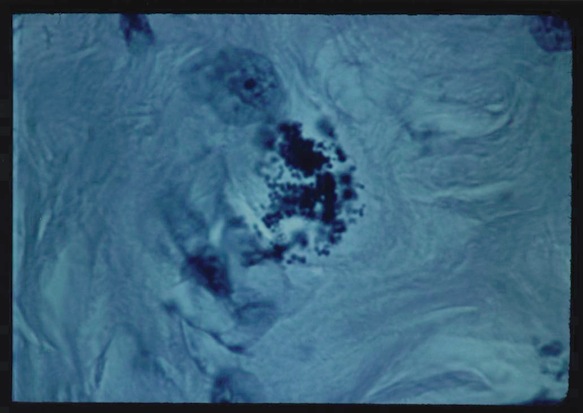
Figure
1. Histopathologic tissue section of original breast cancer showing grape-like
clumps of variably-sized
non-acid-fast coccoid forms. Intensified Kinyoun's (acid-fast) stain,
magnification x1000, in oil.
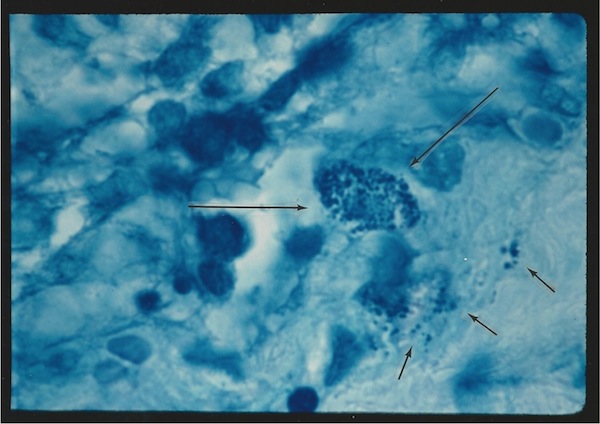
Figure
2. Breast cancer showing a clump of intracellular coccoid forms (long
arrows)
and scattered extracellular coccoid forms. Acid-fast stain, x1000, in
oil.
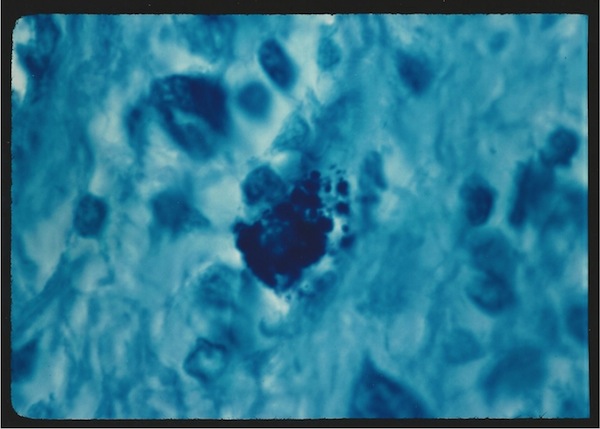
Figure
3. Breast cancer showing a tightly-packed intracellular clump of still
larger round coccoid forms. Acid-fast stain, x1000, in oil.
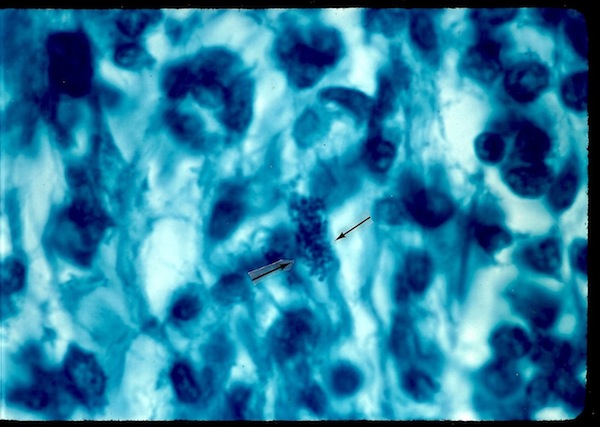
Figure
4. Breast cancer showing a focus of extracellular tiny "granular"
coccoid forms. Acid-fast stain, x1000, in oil.
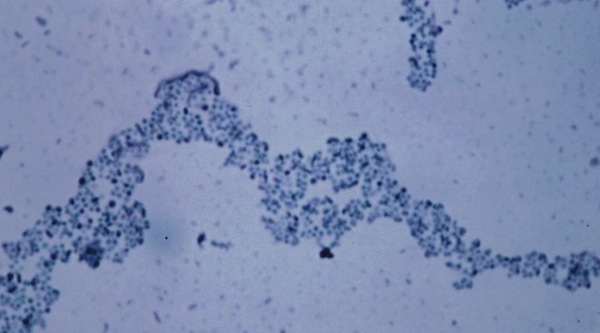
Figure
5. Staphylococcus epidermidis cultured from metastatic breast cancer to
the skin.
The cocci are not acid-fast. Compare the size and shape of these cocci
to those seen in the original
breast cancer. Ziehl-Neelsen (acid-fast) stain, x1000, in oil.
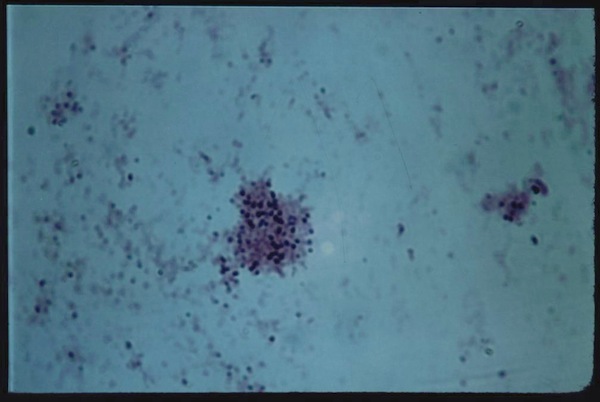
Figure
6. Staphylococcus epidermidis cultured from metastatic beast cancer to
the skin.
The staining quality of the cocci varies from Gram-positive (i.e. purple-stained)
to pink. Gram stain, x1000, in oil.
Recent
discoveries pertaining to cancer bacteria
In 2005 the Nobel Prize in Medicine was
awarded to Australians Barry Marshall and Robin Warren for their discovery
in the 1980s of the bacterium Helicobacter pylori and its role
in gastritis and peptic ulcer disease. This infection can sometimes result
in stomach cancer. The discovery proved that stomach ulcers were not due
to diet, spicy food, alcohol, or psychiatric disorders, as previously
believed. Physicians also previously believed that bacteria could not
survive and flourish in the acid environment of the stomach. What was
also essential in showing Helicobacter was the use of a special
stain to identify these pleomorphic bacteria in stomach tissue. To also
illustrate how one physician can be correct — and the rest wrong — is
the fact that American pathologist A. Stone Freedberg [1908-2009] found
similar bacteria in stomach ulcers decades before, in 1940. Unfortunately,
he discontinued this research when doubting colleagues could not confirm
his work and considered such an infection impossible.
In this new century the Human Microbiome
Project has already revealed that 90% of the cells of the human body are
not human cells. In actuality, the estimated 100 trillion cells are mostly
bacterial in origin. Some writers now refer to us as “superorganisms.”
Little is known about most of these germs and their affect on health and
disease, especially diseases of old age and cancer. Livingston often said
these body bacteria live peacefully within us in "symbiosis."
However, when the immune system is weakened and/or when tissue is damaged,
these bacteria proliferate and cause cellular inflammation. Inflammation
is a precursor to the development of cancer; and cancer kills off one-third
of the world’s population. According to the World Health Organization,
one-third of the world’s population also has latent tuberculosis (TB).
The tragically forgotten cancer microbe
Why
do so many physicians automatically reject cancer microbe research? Medical
historian Lawrence Broxmeyer, MD, in ‘Cancer: A new perspective,’ (2011)
posted online, believes James Ewing (now widely regarded as “the father
of oncology”) condemned the research in 1919 because it conflicted with
his radium interests and his financial investment in newly described radiation
cancer therapy. In the 1950s prestigious pathologist Cornelius Rhoads
also saw the research as a threat to his lucrative cancer chemotherapy
interests. Broxmeyer’s controversial views are also expressed online in,
‘Is cancer just and incurable infectious disease?’ (2004) , as well as
our co-authored ‘Is HIV a virus-like form of acid-fast tuberculosis type
bacteria?’ (2008), posted on the www.joimr.org
website.
In
the years before her death Livingston was widely condemned as a quack
by her colleagues. When she used an “autogenous” vaccine from the patient’s
own cultured cancer bacteria to try to enhance the immune system response,
she was highly criticized. (For more, read ‘Virginia Livingston: Cancer
quack or medical genius?’) A damning report on her bacteria and vaccine
entitled, ‘Autogenous vaccine: A defense against the bacterial organism
that causes cancer, [2001]’ is presented online by Saul Green, PhD. Published
by The Scientific Review of Alternative Medicine, he references
47 published papers, some of which are the same ones I use here to defend
her work. However, he omits references to any of my 11 papers published
in peer-reviewed journals illustrating cancer microbes in cancer tissue
and in lab culture taken from patients with breast cancer, Kaposi’s sarcoma,
and various forms of lymphoma. He also omits the formidable cancer research
of Florence Seibert.
In my experience as
a physician and octagenarian, I have learned that once doctors are
carefully taught an important “fact” —such as “bacteria do
not cause breast cancer” — it is difficult, if not impossible,
for them to change their mind. I suppose it has to do with the
security of being in sync with what your colleagues believe to be
true and not making waves. With the demise of the “breast cancer
virus” that so many oncologists believed in, perhaps we can again
take a second look at cancer bacteria.
Sherlock Holmes once
famously said to Doctor Watson: ‘You see but you do no observe.’
In this regard it took me a decade of observation of the microbe in
various skin disease tissue to convince myself that Livingston and
her women colleagues were correct. When I first met her in the
mid-1960s, our mutual interest was primarily the very rare
red-stained acid-fast TB-like rod forms we independently discovered
in scleroderma tissue . For a long time I could “see,” but I
did not carefully observe the other pleomorphic bacterial forms that
were plentiful in scleroderma (especially the spectacular “large
body” fungus-like forms I rarely observed). I was taught nothing
about them in medical school and they weren’t found in medical
textbooks. As a dermatologist in training, I couldn’t understand
why expert microbiologists and pathologists did not report them, or
provide a clear understanding of their origin. Finally, through
painstaking observation, I developed the confidence to realize that
microbes could indeed be seen in cancer, as other researchers had
demonstrated years before.
For the prevention and
treatment of cancer to advance significantly in this new century we have
to understand clearly that “we” are microbes, and microbes are “us.” We
are inseparable and we share an existential existence. Perhaps with that
knowledge, we can begin to conquer cancer by maintaining and restoring
the symbiosis between “them” and “us”.
SELECTED REFERENCES
Alexander-Jackson
E: A specific type of microorganism isolated from animal and human cancer:
Bacteriology of the organism. Growth
18:37-51,
1954.
Cantwell
AR Jr, Kelso DW: Microbial findings in cancer of the breast and in
their metastases to the skin. J
Dermatol Surg Oncol
7:483-491, 1981.
Cantwell
AR Jr: The
Cancer Microbe: The Hidden Killer in Cancer, AIDS, and Other Immune
Diseases.
Aries Rising Press, Los Angeles, 1990.
Diller
IC: Growth and morphologic variability of pleomorphic, intermittently
acid-fast organisms isolated from mouse, rat, and human malignant
tissues. Growth
26:181-209, 1962.
Hess
DJ: Can
Bacteria Cause Cancer? Alternative Medicine Confronts Big Science.
New York University Press, New York, 1997.
Livingston-Wheeler
VWC, Addeo EG: The
Conquest of Cancer.
Franklin-Watts, New York, 1984.
Nuzum
JW: A critical study of an organism associated with a transplantable
carcinoma of the white mouse. Surg
Gynecol Obstet
33:167-175, 1921.
Nuzum
JW: The experimental production of metastasizing carcinoma in the
breast of the dog and primary epithelioma in man by repeated
inoculation of a micrococcus isolated from human breast cancer. Surg
Gynecol Obstet
11:343-352, 1925.
Scott
MJ: The parasitic origin of carcinoma. Northwest
Med
24:162-166, 1925.
Scott
MJ: More about the parasitic origin of malignant epithelial growths.
Northwest
Med
25:492-498, 1925.
Seibert
FB, Yeomans F, Baker JA, et al: Bacteria in tumors. Trans
NY Acad Sci 34(6):504-533,
1972.
Wainwright
M: Extreme pleomorphism and the bacterial life cycle: A forgotten
controversy. Perspectives
in Biology and Medicine
40:407-414, 1997.
Wainwright
M: Highly pleomorphic staphylococci as a cause of cancer. Med
Hypothesis
54:91-4, 2000.
Wuerthele
Caspe (Livingston) V, Alexander-Jackson E, Anderson JA, et al:
Cultural properties and pathogenicity of certain microorganisms
obtained from various proliferative and neoplastic diseases. Amer
J Med Sci
220:628-646, 1950.
Wuerthele-Caspe
Livingston V, Alexander-Jackson E: An experimental biologic approach
to the treatment of neoplastic disease. J
Amer Med Women's Assn 20:858-866,
1965.
Wuerthele Caspe
Livingston V, Livingston AM: Demonstration of Progenitor Cryptocides
in the blood of patients with collagen and neoplastic diseases. Trans
NY Acad Sci 34(5):433-453, 1972.
Wuerthele
Caspe Livingston V, Livingston AM: Some cultural, immunological, and
biochemical properties of Progenitor cryptocides. Trans
NY Acad Sci
36(6):569-582, 1974.
Young
J: Description of an organism obtained from carcinomatous growths.
Edinburgh
Med J
(New Series) 27:212-221, 1921.
Young
J: An address on a new outlook on cancer: Irritation and infection.
Brit
Med J,
Jan 10, 1925, pp 60-64.
______________________________________________________
Dr.
Cantwell is a retired dermatologist. He is the author of The Cancer Microbe;
and Four Women Against Cancer, both available through Amazon.com. Email:
alancantwell@sbcglobal.net
Feedback to Dr. Cantwell's latest brilliant article...
From:
User ID: 274349
RE:
Breast Cancer Is Caused By Pleomorphic Bacteria
Best article I've ever read on Rense.com
From:
KB
Date: December 13, 2014 3:06:13 PM PST
To: alancantwell@sbcglobal.net
Subject: Rife
Greetings Dr. Cantwell,
I often read your articles (published) on Rense, with great interest,
but one wonders why Rife seems to be seldom (if ever) mentioned when knowledgeable
people speak about pleomorphic bacteria. You may well have good reason
to ignore Rifes' work (?), but I feel certain that your readers would
appreciate a few lines regarding this matter. I'm not expert enough on
such issues to "lock-horns" with you on the subject, so please let this
email represent nothing more than the manic raving of a surprised layman,
as it were.
Regards,
KB
From: Beda Angehrn
Date: December 13, 2014 3:35:54 PM PST
To: alancantwell@sbcglobal.net
Subject: cancer research
Dear Dr. Cantwell
At the website of Jeff Rense I recently read an interesting article by
you concerning bacteria as cause of some types of cancer.
May I mention that there are quite a few german researchers with very
similar findings, most famous among them Prof. Enderlein. But they experienced
a very similar fate, they were ridiculed, they were just ignored by mainstream
colleagues and mainstream research centers or they were charged with quackery.
Thank you for your courage!
Sincerely yours
Beda Angehrn
|





